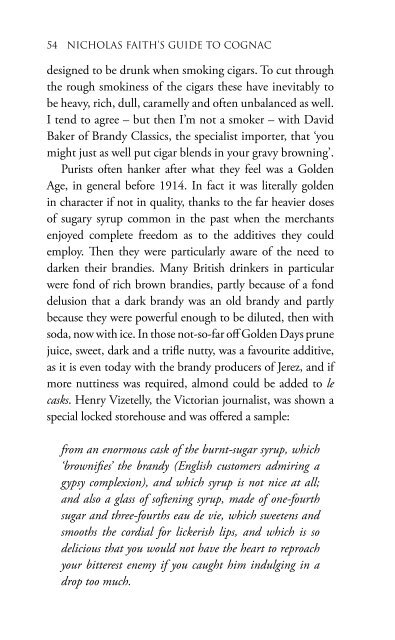Create successful ePaper yourself
Turn your PDF publications into a flip-book with our unique Google optimized e-Paper software.
designed to be drunk when smoking cigars. To cut through<br />
the rough smokiness of the cigars these have inevitably to<br />
be heavy, rich, dull, caramelly and often unbalanced as well.<br />
I tend to agree – but then I’m not a smoker – with David<br />
Baker of Brandy Classics, the specialist importer, that ‘you<br />
might just as well put cigar blends in your gravy browning’.<br />
Purists often hanker after what they feel was a Golden<br />
Age, in general before 1914. In fact it was literally golden<br />
in character if not in quality, thanks to the far heavier doses<br />
of sugary syrup common in the past when the merchants<br />
enjoyed complete freedom as to the additives they could<br />
employ. Then they were particularly aware of the need to<br />
darken their brandies. Many British drinkers in particular<br />
were fond of rich brown brandies, partly because of a fond<br />
delusion that a dark brandy was an old brandy and partly<br />
because they were powerful enough to be diluted, then with<br />
soda, now with ice. In those not-so-far off Golden Days prune<br />
juice, sweet, dark and a trifle nutty, was a favourite additive,<br />
as it is even today with the brandy producers of Jerez, and if<br />
more nuttiness was required, almond could be added to le<br />
casks. Henry Vizetelly, the Victorian journalist, was shown a<br />
special locked storehouse and was offered a sample:<br />
from an enormous cask of the burnt-sugar syrup, which<br />
‘brownifies’ the brandy (English customers admiring a<br />
gypsy complexion), and which syrup is not nice at all;<br />
and also a glass of softening syrup, made of one-fourth<br />
sugar and three-fourths eau de vie, which sweetens and<br />
smooths the cordial for lickerish lips, and which is so<br />
delicious that you would not have the heart to reproach<br />
your bitterest enemy if you caught him indulging in a<br />
drop too much.<br />
Even the normally puritanical Tovey approved of such<br />
additions:<br />
the old <strong>Cognac</strong> houses are very particular in the quality<br />
of their colouring, and prepare it with great lie; it is<br />
important, too, that it should be old, and it is made<br />
up with Old Brandy. Consequently good old colouring<br />
imparts a fulness and roundness to Brandy which is not<br />
to be met with in the coloured spirit, although the latter<br />
may merit the preference in character and finesse.<br />
Both ‘dosage’ and dilution are delicate operations. Only a<br />
few of the oldest cognacs, those of at least forty years old,<br />
are weak enough to be sold without dilution; the younger<br />
the blend, the stronger the basic spirit. To bring a threeyear-old<br />
down from perhaps 60° to 40° is a delicate business.<br />
‘The dilution can never be too brutal,’ says Michel Caumeil,<br />
who compares it with landing an aeroplane – after all, there<br />
are four hundred ingredients in the cognac which have to<br />
be blended with the water. Reducing strength is bound to<br />
be an important step which, if taken too quickly, can do<br />
severe damage to the cognac, for spirit and water do not mix<br />
naturally. When brandy is blended with water, molecules of<br />
fatty acids clash and the result is the sort of cheap, soapy<br />
cognacs found in all too many French supermarkets.<br />
The decision is irreversible: ‘once a cognac has been cut,’<br />
says Caumeil, ‘it can never go into one of our best blends.’<br />
But even the meanest spirit cannot be brought down from<br />
its cruising altitude (or undiluted strength) in one go. The<br />
process occurs in several stages, each of them separated by<br />
a period of months – and, say some blenders, the last stage,<br />
reducing the strength from 45 to 40 per cent, is the most


